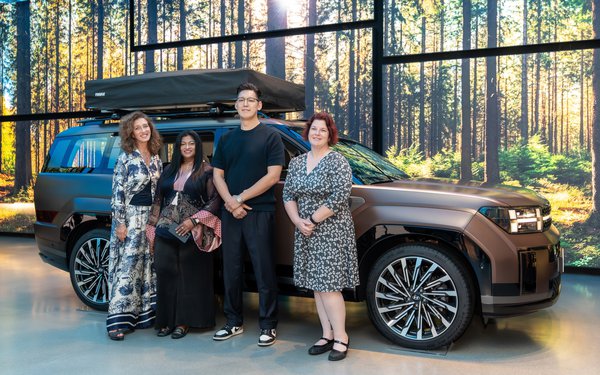
Editor's Note: This
story ran in a previous edition
Hyundai Santa Fe will forever be one of my all-time favorite vehicles.
I drove both the previous generation of the SUV and the redesigned model across country as part of Operation Frodo, a cross-country dog rescue
mission, so I got to know both versions of the vehicle very well.
While the old model was solid, the new version included all kinds of improvements. It was dramatically
restyled both inside and out to include many “wow” features like a wider liftgate opening and spacious interior.
advertisement
advertisement
The Santa Fe aims to expand everyday experiences
by connecting urban customer activities with natural environments. One of my favorite things about the Santa Fe is a third row that folds perfectly flat, which is more unusual than you might think.
It’s just one more thoughtful touch from the Hyundai designers.
My colleagues agreed with me. The Hyundai Santa Fe was declared the World’s Best Car for 2025 by the 82
journalists judging the Women’s Worldwide Car of the Year. Prior to casting their votes, the women, hailing from 55 nations, diligently tested numerous car models.
I recently
was one of three jurors selected to represent the group in Seoul, South Korea where we presented Hyundai with the award, toured the Ulsan plant where it is produced and interviewed Taewook Choi, the
vehicle’s exterior designer.
Choi filled us in on the ins and outs of the redesign. Here is part of our conversation, edited for space.
How long did you
work on this model?
The design phase took about 1.5 to 2 years, though I don’t remember the exact timeline. After the design was finished, the development and
vehicle testing period lasted around one year. So, in total, it was roughly about three and a half years.
What inspired the dramatic styling changes?
We have always been responsive to changing times and to our customers’ voices. During the development of this vehicle, COVID-19 was a significant factor. While exterior styling is
often the main focus, with this model, we started by focusing on designing the interior "alpha space.” We extended the wheelbase and increased the rear overhang.
How do
designers and engineers work together to reconcile different constraints?
That process happens repeatedly from start to finish. Early on, we propose a direction and then receive
feedback on whether it’s technically feasible or not. At the beginning, if the number of things deemed impossible was 100, through mutual compromise and adjustments, that number gradually
decreases as we work together to develop the car.
Anything you’d like to point out about the design?
We talk a lot about the rear, and the
tailgate opening is really large—bigger than any other car. In the case of the Santa Fe, there was initially some feedback about the tail lamps being positioned quite low. I wanted to explain
that this was because of the large usability and the various functions that required the lamps to be placed lower. There were complaints about the lamps being low from a styling perspective, but this
was actually the result of satisfying all those functional needs. (It sits in the tailgate.) This is exactly what the car was designed for.
What is your favorite feature in the
Santa Fe?
My favorite part is the C-pillar handle. That idea actually started off as a bit of a joke, something we
threw out casually. But then we got a lot of feedback saying, “Hey, this could actually be a new unique selling point.” Initially, we spent a lot of time figuring out the grip style
— how people would actually hold it — and where to place this feature. We debated whether it should be flush, protruding, or recessed. In the end, we went with a flush type. It can support
a heavy load, up to 441 pounds. Creating a structure strong enough to hold that much weight was challenging, so there’s a real sense of pride that this idea, which started out as a joke,
ended up becoming an actual feature.
